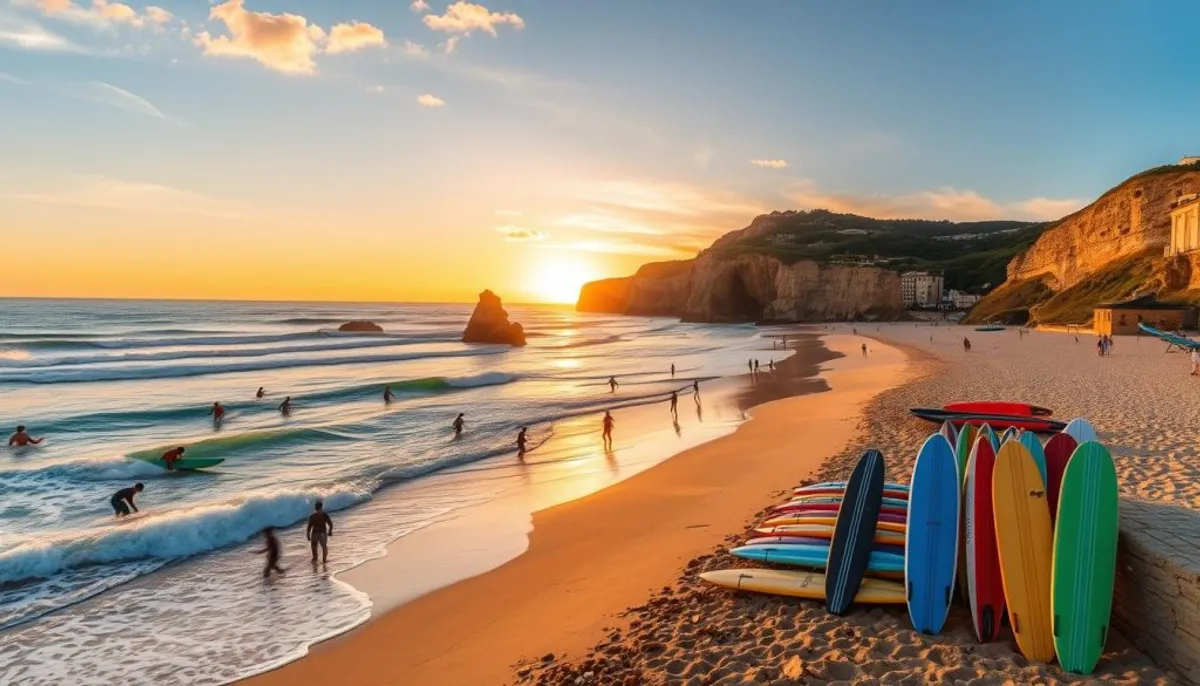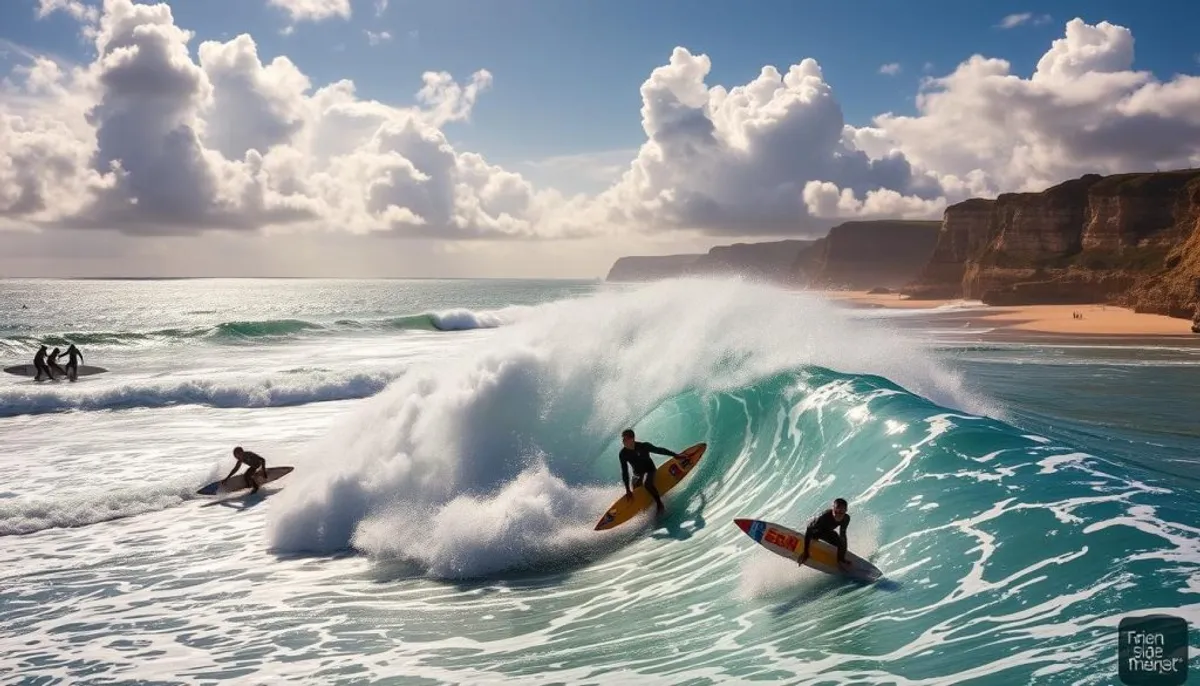The surfing in France transcends the simple status of a water sport. It represents a deep passion, capturing the essence of many surfers on the French coasts. This activity, demanding strength and perseverance, has deeply integrated into the culture of the country.

Regions such as the Basque Coast, Les Landes, Brittany, and the Mediterranean host diverse surfing spots. The lifestyle associated with these places has forged a united community, bound by love for the ocean.
The surf culture in France goes beyond mere sporting practice. It also encompasses music, art, and a unique clothing style. Inspired by the Polynesian origins of surfing, it adds a distinctly French touch.
Major events like the Quiksilver Pro France attract surfers from everywhere, highlighting France's reputation in the surfing world. This passion for waves continues to grow, creating a unique way of life on the French coasts and a true urban culture.
The Origins of Surfing in France
The history of surfing in France is rich and captivating. It begins on the Basque coast, specifically in Biarritz, which becomes the heart of French surfing. This activity, born in Polynesia in the 16th century, finds a conducive environment on French beaches.
The Arrival of Surfing on the Basque Coast
In July 1957, the first French waves were conquered by pioneers in Biarritz, on the Côte des Basques. This date symbolizes the beginning of a passion that will grow endlessly. In 1959, the Waïkiki Surf Club, the first surf club in France, was founded by legendary surfers like Lamarque, Barland, Plumcocq, and Etchepare.
The American and Australian Influence
Foreign influence is essential in the evolution of surfing in France. American and Australian surfers deeply inspire the French community. This influence is seen in the improvement of boards, equipment, and surf-specific vocabulary.
The Development of the First Surf Schools
Surf schools quickly emerged, democratizing the sport. In 1964, the Surf Club of France was established, followed by the French Surfing Federation, founded by the mayor of Biarritz, Guy Petit. These institutions play a key role in the growth and professionalization of surfing.
| Year | Event |
|---|---|
| 1957 | First waves surfed in Biarritz |
| 1959 | Creation of the Waïkiki Surf Club |
| 1964 | Foundation of the Surf Club of France and the French Surfing Federation |
Today, France has about 1 million surfers, including 80,000 members of the French Surf Federation. The Côte des Basques in Biarritz remains the most popular surfing spot in Europe, underscoring the importance of this region in the history of French surfing.
The Surf Culture: A French Way of Life
Surfing in France goes beyond being just a sport to become a true art of living. Since the 1950s, it has deeply integrated into French culture. It creates a unique surf lifestyle, blending passion for the ocean and essential values.
The French Surfers' Way of Life
French surfers have developed a distinct lifestyle marked by freedom and respect for nature. Their surf lifestyle draws inspiration from the American counterculture of the 1970s, enriched by a French touch. The community values athletic growth and environmental protection, thus forging an authentic way of living.
The Impact on Fashion and Style
Surf fashion has profoundly influenced French clothing style. Brands like Roxy have introduced specific clothing, combining functionality and aesthetics. This laid-back style, emblematic of the free spirit of surfing, has extended beyond the beaches, becoming a pillar of contemporary French fashion.
The Surf Community in France
The surf community in France is unified and vibrant. It gathers around shared values, such as respect for the ocean and the pursuit of unique sensations. This community also expresses itself through music, notably surf music, reinforcing the cultural identity of French surfing. Events like international competitions on the west coast strengthen this passionate community.
The Iconic Surf Spots in France
France is a true goldmine for surfing enthusiasts, attracting surfers from all over the world. Its coasts host legendary waves, offering unforgettable experiences for everyone. Whether you are a beginner or an expert, there is something for you.
Biarritz, the birthplace of surfing in Europe, shines with its Côte des Basques. Since the 1950s, this historic spot has welcomed surfers of all levels. Further north, Hossegor stands out for its powerful waves. La Gravière, famous for its impressive rolls, is a challenge for the most daring.
In Brittany, La Torche is renowned for its waves suitable for all levels. Its varied conditions are ideal for progression. Additionally, visitors can experience authentic experiences in Thailand. The North Beach of Lacanau in Gironde attracts crowds with its prestigious competitions and quality waves.
Les Landes also offer many varied spots. Les Estagnots in Seignosse are known for their graceful waves. Further north, Bud Bud in Vendée attracts with its consistent waves, ideal for learning.
| Spot | Region | Level |
|---|---|---|
| Côte des Basques | Biarritz | All levels |
| La Gravière | Hossegor | Experienced |
| La Torche | Brittany | All levels |
| Lacanau North | Gironde | Intermediate to expert |
| Bud Bud | Vendée | Beginner to intermediate |
These iconic spots are the pride of French surfing. Each year, they attract thousands of enthusiasts in search of perfect waves and a unique atmosphere.
The Champions Who Shaped History
France stands out with a team of French surfing champions, who have etched their names in the history of this sport. These extraordinary athletes have played a key role in France's emergence on the global surfing scene.
Jérémy Florès: The French Pioneer
Jérémy Florès is an icon of French surfing and French fashion. The first French surfer to win global competitions, he paved the way for a new era of talent. His unique style and ability to excel in extreme conditions have inspired many young surfers.
Johanne Defay: Excellence in Women’s Surfing
Johanne Defay is a figure in the elite of women's surfing. She proudly represents France in international competitions. Her flawless technique and total commitment make her a formidable opponent on the professional circuit.
Michel Bourez: The Tahitian Power
Michel Bourez, nicknamed “the Spartan”, embodies the strength of Tahitian surfing. His explosive style and audacity in the face of gigantic waves have elevated him among the best surfers in the world.

| Surfer | Specialty | Notable Achievements |
|---|---|---|
| Jérémy Florès | Versatility | Winner of Pipe Masters 2010 |
| Johanne Defay | Technique | 3rd in WSL 2016 |
| Michel Bourez | Power | Triple CT winner |
These French surfing champions have shone on the podiums and inspired a new generation. Their journey illustrates the vitality of French surfing on the global stage.
The Surf Economy in France
The surf economy in France shows impressive growth, reaching 1.5 billion euros in 2024. This sector, representing 1.5% of the global industry's overall revenue, is in full expansion.
The Surf Wear Industry
The surf wear industry in France is thriving. In Aquitaine, brands like Quiksilver and Rip Curl are experiencing notable growth. This region is home to about 10 surf-related clothing companies, employing nearly 350 people. The surf shops, numbering 60, generate an estimated revenue of 100 million francs.
Surf Tourism
Surf tourism plays a crucial economic role for coastal regions. New Aquitaine, the cradle of French surfing, attracts hundreds of thousands of surfers every summer. Brittany, the second surfing region, welcomes nearly 300,000 practitioners per year, generating 17.5 million euros in revenue.
Schools and Training
Surf training is experiencing significant growth. The number of surf schools has doubled in 5 years. Between 2019 and 2023, the number of BPJEPS certificates issued has more than tripled. These schools, mostly small structures, play a crucial role in spreading surf culture and creating local jobs.
The surf economy in France, supported by the surf wear industry, surf tourism, and surf training, continues to develop. It offers great prospects for the future.
Major Competitions on the Territory
France is the stage for several top-tier surfing competitions. These events attract the crème de la crème of global surfing, captivating the hearts of glide enthusiasts.
The Quiksilver Pro France, located in Hossegor, is a prestigious event within the global WSL circuit. Annually, it takes place on the tumultuous waves of the Landes coast. It highlights the most talented international surfers, often in breathtaking conditions.

The Roxy Pro France, its female equivalent, takes place in parallel. It is an elite women's surfing championship, offering a spectacle as impressive as its male counterpart.
The French surfing championships also mark a highlight in the calendar. This national competition brings together top-level French athletes in various categories. It allows for the crowning of national champions and the discovery of new talents, while addressing issues such as mass consumption.
| Competition | Location | Period |
|---|---|---|
| Quiksilver Pro France | Hossegor | October |
| Roxy Pro France | Hossegor | October |
| French Championships | Various spots | May-June |
The calendar of French surfing competitions is enriched by other events. The Surf Open of Lacanau in Gironde and the Coupe de France by team are essential meetings for the surfing community in France.
The Evolution of Practices and Equipment
France has seen a remarkable transformation in the field of surfing. Techniques and equipment have evolved significantly. The emergence of the evolution of organizational culture has also played a role in this dynamic. Old boards have been replaced by more advanced technologies, offering surfers exceptional performance.
From Traditional Boards to Modern Technologies
Technical advances have revolutionized surfboards. Modern materials, such as acrylonitrile butadiene styrene, have replaced wood. These innovations have improved the maneuverability and durability of boards. They have allowed surfers to explore new ways to ride the waves.
The Emergence of New Disciplines
The world of surfing has seen the emergence of new disciplines. Stand-up paddle and bodyboarding have gained popularity. These sliding sports have attracted a diverse audience, enriching the surf culture in France.
Adaptation to Local Conditions
French surfers have developed specific techniques to navigate local waves. This adaptation has led to the emergence of unique styles, reflecting the diversity of French surfing spots. Innovations such as wetsuits have allowed surfing year-round, even in cold waters.
| Evolution | Impact |
|---|---|
| Light materials | Better performance |
| New disciplines | Diversification of practices |
| Local techniques | Adaptation to French spots |
| Wetsuits | Surfing all year round |
The evolution of surfing in France illustrates a dynamic of continuous innovation. Technological advances have transformed the practice, paving the way for new disciplines. This ongoing evolution promises a bright future for French surfing, with new waves to explore.
Conclusion
The surf culture in France has undergone significant evolution since the 1950s. From Biarritz to Hossegor, passing through Anglet, the surf heritage has deeply rooted itself in the coastal landscape. These localities have transformed into true sanctuaries for glide enthusiasts.
The future of French surfing looks promising. Events like the Quiksilver Pro France and the Lacanau Pro attract the best surfers in the world. Figures like Jérémy Florès and Joan Duru embody the French spirit, motivating a new generation of surfers.
The sustainable surf culture is gaining importance in the industry. French brands such as Quiksilver and Rip Curl, created in the 1980s, are committed to environmental protection. This movement reflects surfers' commitment to ocean conservation.
Surfing in France continues to develop, blending tradition and innovation. It represents a distinct art of living, attracting enthusiasts from everywhere, while preserving its authenticity and connection to nature. Additionally, professional dance classes add a rich cultural dimension to this dynamic scene.
RelatedRelated articles


